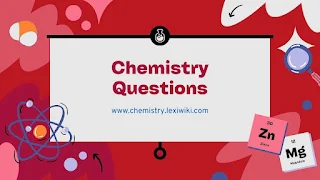Questions about Alkenes and Alkynes (Organic Chemistry)
20 multiple-choice questions about Alkenes and Alkynes in Organic Chemistry, each with five alternatives (A–E). At the end, you'll find the answer key with detailed explanations.
-- Ads --
Alkenes and Alkynes — Multiple Choice Questions
1. What type of bond is found in alkenes?
A) Single bond
B) Double bond
C) Triple bond
D) Ionic bond
E) Aromatic bond
2. Which of the following hydrocarbons contains a triple bond?
A) Ethene
B) Propane
C) Ethyne
D) Butane
E) Cyclohexane
3. What is the general formula for alkenes?
A) CₙH₂ₙ
B) CₙH₂ₙ₊₂
C) CₙHₙ
D) CₙH₂ₙ₋₂
E) CₙH₂ₙO
4. What is the IUPAC name for C₂H₄?
A) Ethane
B) Ethene
C) Ethyne
D) Acetylene
E) Propene
5. What is the IUPAC name for the compound commonly known as acetylene?
A) Ethene
B) Ethyne
C) Ethane
D) Propene
E) Methyne
6. Which of the following compounds is an alkyne?
A) Butene
B) Ethene
C) Propane
D) Butyne
E) Cyclobutane
7. Which type of reaction do alkenes readily undergo?
A) Addition
B) Substitution
C) Polymerization
D) Combustion only
E) Neutralization
8. What is the IUPAC name for CH₃–CH=CH₂?
A) Ethene
B) Propane
C) Propene
D) Propanol
E) Butene
9. What is the primary structural difference between alkanes and alkenes?
A) Alkanes contain nitrogen
B) Alkenes have a carbon-carbon double bond
C) Alkanes have triple bonds
D) Alkenes contain oxygen
E) Alkenes are aromatic
10. What type of bond is found in alkynes?
A) Double
B) Aromatic
C) Triple
D) Single
E) None
11. What is the molecular formula for butyne (an alkyne with four carbon atoms)?
A) C₄H₁₀
B) C₄H₆
C) C₄H₈
D) C₄H₄
E) C₄H₁₂
12. What is the IUPAC name for CH≡CH?
A) Ethyne
B) Ethane
C) Ethene
D) Acetone
E) Propene
13. What physical property is affected by the presence of double or triple bonds in hydrocarbons?
A) Color
B) Boiling point
C) Magnetism
D) Taste
E) Transparency
14. Which compound is an example of an alkene?
A) CH₄
B) C₂H₂
C) CH₃CH=CH₂
D) CH₃CH₂CH₃
E) CH≡CH
15. Which of the following statements is TRUE about alkenes and alkynes?
A) They are saturated hydrocarbons
B) They are less reactive than alkanes
C) They undergo addition reactions
D) They contain only single bonds
E) They are only found in gases
16. How many π (pi) bonds are present in ethyne (C₂H₂)?
A) 0
B) 1
C) 2
D) 3
E) 4
17. Which compound has both double and triple bonds?
A) CH₃–C≡CH
B) CH₂=CH–CH₃
C) CH₂=C=CH₂
D) CH≡C–CH=CH₂
E) C₄H₁₀
18. What is the IUPAC name of a hydrocarbon with the formula C₃H₄?
A) Propane
B) Propene
C) Cyclopropane
D) Propyne
E) Methylacetylene
19. Alkenes and alkynes are considered:
A) Saturated hydrocarbons
B) Alcohols
C) Unsaturated hydrocarbons
D) Aromatic hydrocarbons
E) Aldehydes
20. What kind of hybridization is present in carbon atoms of an alkyne?
A) sp³
B) sp²
C) sp
D) dsp³
E) sp³d
- Questions about Hydrocarbons (Organic Chemistry)
- Questions about Straight-Chain Alkanes (Organic Chemistry)
- Questions about Branched Alkanes in Organic Chemistry
✅ Answer Key with Extended Explanations
1. B – Alkenes have at least one carbon–carbon double bond.
2. C – Ethyne (C₂H₂) is an alkyne with a triple bond.
3. A – Alkenes follow the formula CₙH₂ₙ, assuming one double bond.
4. B – C₂H₄ is ethene, the simplest alkene.
5. B – Acetylene is the common name for ethyne (C₂H₂).
6. D – Butyne is an alkyne (C₄H₆), containing a triple bond.
7. A – Alkenes undergo addition reactions due to the double bond.
8. C – CH₃–CH=CH₂ is propene, an alkene.
9. B – Alkenes have at least one double bond, unlike alkanes.
10. C – Alkynes contain a triple bond between two carbon atoms.
11. B – Butyne’s formula is C₄H₆ (CₙH₂ₙ₋₂ for alkynes).
12. A – CH≡CH is ethyne.
13. B – The presence of multiple bonds affects boiling and melting points.
14. C – CH₃CH=CH₂ (propene) is an alkene.
15. C – Alkenes and alkynes are more reactive than alkanes due to addition reactions.
16. C – Ethyne has one σ bond and two π bonds in the triple bond.
17. D – CH≡C–CH=CH₂ contains both double and triple bonds.
18. D – C₃H₄ is propyne, an alkyne with three carbon atoms.
19. C – Alkenes and alkynes are unsaturated hydrocarbons.
20. C – Carbon atoms in alkynes are sp hybridized due to linear geometry.
Dive into the groundbreaking science of neurotransmitters—your brain’s invisible architects—in Chemical Harmony: How Neurotransmitters Shape Our Lives (2025). This meticulously researched book reveals how serotonin, dopamine, GABA, and other brain chemicals silently orchestrate every aspect of your existence, from decision-making and relationships to mental health and emotional resilience.Click here to buy
Share Online!

